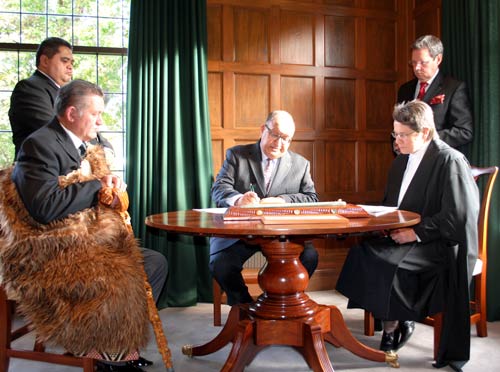
In 1995 Waikato-Tainui became the first iwi to reach a Treaty of Waitangi settlement with the Crown. The Māori Queen, Te Arikinui Dame Te Atairangikaahu, signed the deed of settlement with Prime Minister Jim Bolger at Tūrangawaewae Marae. Queen Elizabeth II gave the royal assent to the Waikato Raupatu Claims Settlement Act during a visit to New Zealand later that year, signing it in the presence of Te Arikinui and Waikato kaumatua. This settlement provided redress and an apology for the confiscation of Waikato-Tainui lands following war in the 1860s.
Fifteen years later, in 2010, Te Arikinui’s son, King Tūheitia (left in this image) was present as the Waikato-Tainui Raupatu Claims (Waikato River) Settlement Act was signed into law by Governor-General Anand Satyanand (centre). The purpose of this Act was to ensure the health and wellbeing of the Waikato River for future generations, and to establish co-management of the river by the Crown and Waikato-Tainui.
On the table is the ceremonial pounamu mere Te Raupatu, which Waikato-Tainui gifted to the Crown at the time of the first settlement.
Using this item
The Governor-General of New Zealand
This item has been provided for private study purposes (such as school projects, family and local history research) and any published reproduction (print or electronic) may infringe copyright law. It is the responsibility of the user of any material to obtain clearance from the copyright holder.









Add new comment